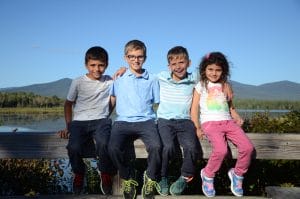 The Romano kids on the road. Photo: Sarah Boudreau-Romano
The Romano kids on the road. Photo: Sarah Boudreau-Romano It was a daunting concept: a road trip with children with multiple allergies. Here’s how The Allergist Mom pulled off an East Coast adventure.
Traveling with children with food allergies can present so many challenges that sometimes it feels easier just to stay home. And for a while, that is exactly what we did. I blamed it on the four giant car seats and the kids’ unpredictable behavior (which was honestly a huge part of it). But deep down, I knew it was mostly because the food allergies made it so hard for us.
As a family, we have to avoid more than 10 allergens – milk, eggs, wheat, soy, corn, barley, legumes, peanuts, tree nuts, sesame, plus some foods related to oral allergy syndrome. Avoiding all of these foods makes it tough to prepare meals to eat at home – and finding meals on the road is even tougher.
At a certain point, however, we made the decision that we could not let food allergies stand in the way of living life to the fullest. We started taking single-destination vacations, in places where we could stay at a hotel with a full kitchen, search out good grocery stores, and plan crockpot meals that could be ready when we walked in after a long afternoon in the pool. Slowly but surely we were figuring it out, and then the kids threw me a curveball.
 The kids weighing their handpicked apples at an orchard in New Hampshire.
The kids weighing their handpicked apples at an orchard in New Hampshire. The Challenge
Last year, our twin 4th graders and our 5th grader were learning about the East Coast, and in their exploration, they became enamored with photos of coastal Maine. They started asking about a road trip, even getting their kindergartener sister in on the requests. I laughed out loud at the mere suggestion of it, having just figured out how to manage a stop-and-drop vacation.
A road trip? With multiple hotels, long stints of driving, and day trips with meals on the go? This sounded like an absolute disaster waiting to happen, and one that I would have to find a way to avoid.
I shimmied past the suggestion each time they brought it up – until they started learning about the American Revolution. A road trip out east in the fall, from coastal Maine to the color-changing landscape of the New Hampshire mountains to the history of the Boston Tea Party, then began weaving itself together. So I let the idea simmer for a few minutes, and I was actually able to imagine this big East Coast trip. And it all felt grand until I came back to thinking about the food.
Our family was faced with a choice, and we needed the kids to be a part of the decision. We could let the difficulty of food keep us in one spot, or we could take on the challenge by using what we had learned so far, and continuing to be creative and flexible to make the multi-stop trip work.
My husband and I explained to the kids that food on the road would not taste as good as food at the table, and that there would be a lot of fresh fruits and vegetables to make driving days possible. I said that I want them to take on challenges. If they would like to do something that initially seems too tough for someone with food allergies, I want them to push to make that situation safe for themselves. I don’t want the disease to stand in their way.
Ultimately, we decided as a family to move forward with the road trip. However, if this was going to happen, it had to be thoroughly planned in advance. I buckled down and put in some serious organizing time, and before I knew it, the departure date was upon us.
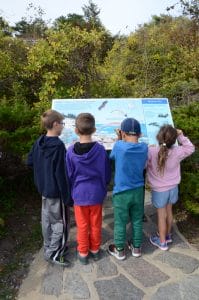 The kids learning about topography and wildlife along the famed Newport, Rhode Island Cliff Walk.
The kids learning about topography and wildlife along the famed Newport, Rhode Island Cliff Walk. The Road Trip
The first day of our family’s inaugural road trip began with a plane ride, so we sort of cheated. With four kids under 10 who aren’t afraid to mix it up in the car, we decided to avoid the stress of a 12-hour drive from Chicago to Vermont and fly instead. We try to take the earliest flight of the day when planes are supposed to be the cleanest, and when there’s less nut-eating. When we got to the gate, as I always do, I let the airline staff know that I was traveling with children with food allergies.
Depending on the airline, they may not serve nuts during your flight, and they may allow pre-boarding in order to clean the seats and surrounding areas. When we can, we take that extra few minutes to put our wipes to work cleaning every single visible surface, from the seatbelt to the window shade.
It was a short flight to Vermont, but we have learned to pack plenty of food in case of delays, and because the kids are always hungry. We have a no-new-foods-on-a-plane rule. Even if a label appears safe, we take a zero-risk approach to eating on an airplane.
We fill a cooler with safe, cleaned and ready-to-eat food in plastic containers. For this trip, we brought our own carrots, apples, grapes and celery. We packed slices of ham and turkey, placing all of these containers on ice in a cooler. We took bags of chips and homemade zucchini muffins. Never budging from our normal routine of cleaning our hands before eating, we did the same on the plane.
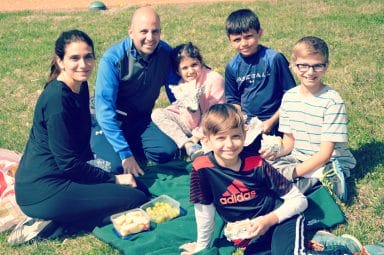 The author, her husband D.J. Romano and the kids enjoy a picnic lunch in Maine.
The author, her husband D.J. Romano and the kids enjoy a picnic lunch in Maine. These rules help to keep the risk of a reaction while flying as low as possible. All of that preparation led to a smooth landing in the greenest state to which I have ever been. After a few minutes spent cleaning and wiping down our rental car, the brood jumped in and we were off to the hotel in Burlington, Vermont.
It is one thing to choose a destination, but quite another to pick a place to stay while you are there. I usually locate the nearest hospital and grocery store and choose a hotel closest to these. Having children with multiple food allergies, we have also learned to stay only at a place that has a full kitchen. (The option to rent a house has also worked for us in the past.) I called ahead of time to let the housecleaning staff know that our family has food allergies, and to ask them to please take extra time cleaning the kitchen surfaces.
When we arrived at the hotel, the kids dashed into the room with excitement, while my husband and I grabbed the wipes and began to wipe down surfaces, just in case. This included the refrigerator, freezer, and dry food shelves, as well as chairs and couches. We should own stock in a baby wipes company!
Usually the hotel kitchens are stocked with pots, pans and utensils, and we have used them in past when they have looked clean or rarely used. But first we scrub them with soap, and run them through the dishwasher. However, we have also been on trips where the pans have had such stubbornly stuck-on food protein that we were forced to run to the store minutes before I should have been serving dinner.
I have planned to use a toaster for breakfast every day, forgetting it would be covered in wheat crumbs. I have grabbed a slotted spatula while making pancakes to find dried omelette in the slots. To a parent of two children who have had anaphylaxis to egg, the sight of dried omelette on a spatula you’re about to use can fill your head with endless “what-ifs.” After enough of these moments, I thought it would be easier to just make our own vacation box of cookware and utensils.
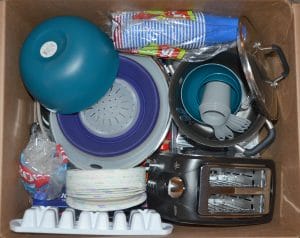 Sarah's vacation box: peace of mind comes with no cross-contact.
Sarah's vacation box: peace of mind comes with no cross-contact. The Road Trip Vacation Box
It has been my most creative problem solver yet: the vacation box. I bought a sturdy cardboard box and loaded it with a toaster, a pot, a sauté pan, a cookie sheet, a strainer, measuring cups, a cutting board, and knives. I bring paper bowls, plates, plastic cups, and silverware. This is hardly environmentally friendly, but I only do this on trips when I want to keep the cross-contamination risks as low as possible.
We treat this box as a piece of luggage, and on this ambitious journey, I said a special prayer when it left on the airport conveyor belt. The vacation box gives me peace of mind; it is reassuring to know that, in a way, you can bring your own kitchen with you. For me, my own kitchen, covered in our own food, is where I feel the safest. Being able to bring along a box that encapsulates this safe feeling has proven highly valuable to our family.
But having taken care of what we’re going to cook with, it then came down to the food itself. Being able to get to the hotel and fill the refrigerator and cabinets pretty quickly was important. You are hungry, but the kids are hungrier.
A game-changer for me on this road trip was planning out the meals individually, and then creating a grocery list based on that plan. If we had spaghetti one night, we would have enough leftovers for lunch the next day. This level of detail took away some of the mental strain of the trip. The reassurance that each day’s meals are covered is a must-have feeling.
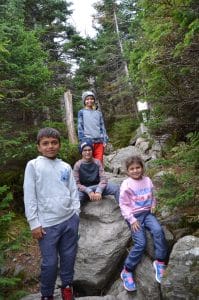 Thermoses of hot food allowed the family to hike in the remote mountains of Vermont.
Thermoses of hot food allowed the family to hike in the remote mountains of Vermont. One thing that can destroy that feeling of success is finding out the brands you always use aren’t available. A few years ago, on a trip to Florida, one grocery store after another didn’t carry the only bread we can eat: tapioca. What in the world were we going to eat for the next week?
We had no choice but to drive for another 45 minutes to a neighboring town. After asking three different people, a young man could sense my panic and his face lit up as he ran me over to two lonely loaves. This literally saved our trip.
With the East Coast adventure, I wasn’t going to make that mistake again. I began to call the grocery stores a few weeks ahead of time to ask if they carried certain brands or items that I needed. Most grocery stores will even hold the food for you, and most will also place special orders. I was able to walk into grocery stores on this trip with confidence. It made me smile, knowing that our tapioca bread would be sitting in the back room, with my name on it.
The second leg of our road trip took us from Vermont to coastal Maine. This was a lengthy drive, so we broke it up with two hikes in New Hampshire: a long, pebbled path that explodes into an enormous, gorgeous pond, and a second excursion that brought us to a jaw-droopingly beautiful 80-foot-high waterfall.
But this long leg of the trip also meant being on the road during a mealtime. I dread out-of-the-kitchen meal management, but these day trips are often the most exciting and worthwhile adventures. To just swing through a drive-through would be a dream, but that was a luxury we didn’t have.
With city visits, even our family with multiple allergies managed to eat at a few allergy-aware restaurants (Chipotle Mexican Grill was our go-to). But with remote sightseeing on the day’s agenda, eating out even at usually reliable spots was not within our comfort zone, even if that had been available.
So, how did we manage the difficult day trip? Reliable coolers. We used a warm cooler packed with Thermoses that are filled with piping hot rice or pasta. Some of these plug right into a car trunk’s 12-volt outlet. Investing in a cooler that is meant to hold ice for a weekend has worked out well, too. We filled it with ready-to-eat fruit and veggies, drinks and ice. The ice stayed frozen in the warm car while we took our long hikes and made our way to Maine.
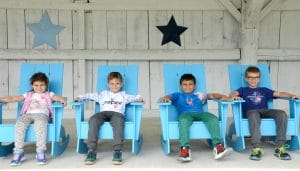 The Romano kids enjoying the sights in Burlington, Vermont.
The Romano kids enjoying the sights in Burlington, Vermont. What We Learned From our First Road Trip
We continued to use these tricks throughout our trip on extended drives to ocean walks in Rhode Island and on long days touring Paul Revere’s house and walking the Boston history tour. Ten days later, when we boarded the plane for home, the kids were so thankful and happy we did it! We managed to take a situation that seemed out of reach for us and we figured it out.
We found solutions for how to take food allergies on the road. Not only was our odyssey an incredible experience for all of us, it was a life lesson: Food allergy will continue to dish out challenges every time you turn around, but through commitment and teamwork, you can create the life you want to live. Sure, this time it was a road trip, but tomorrow it may be something even bigger. This taught us that there is no challenge we can’t take on, nothing that food allergy will stop us from doing if it is important to us.
Dr. Sarah Boudreau-Romano is an allergist and director of the FASE (Food Allergy Support & Education) program at Lurie Children Hospital in Chicago.
Related Reading:
Accidental Chef: Allergist Mom Learns to Love Cooking
Camping with Asthma: How to Prepare and What to Pack
Tips for a Safe and Allergy-Friendly Vacation





